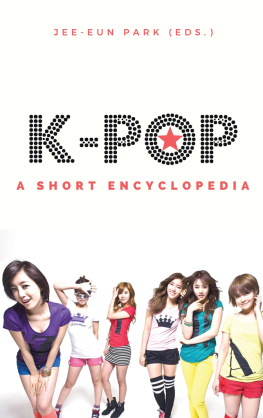CONTENTS
K-Pop. A short encyclopedia.
Content from the K-Pop entry in Wikipedia, the Free Encyclopedia :
Wikipedia contributors. "K-pop." Wikipedia, The Free Encyclopedia., 1 Jan. 2017. Web. 11 Jan. 2017.< https://en.wikipedia.org/wiki/K-pop >
Book and Cover design by William Labelle
First Edition: January 2017
2017,Park, Jee-Eun
Edition : Books on Demand GmbH,
12 / 14 rond point des champs Elyses, 75008 Paris
Impression : BoD - Books on Demand GmbH Norderstedt, Allemagne
ISBN : 9782322160440
Dpt lgal : Janvier 2017
Chapter One
K-pop definition and characteristics
K-pop is a fusion of synthesized music, sharp dance routines and fashionable and colorful outfits
INA Global
K -pop (an abbreviation of Korean pop; Hangul:  ) is a musical genre originating in South Korea that is characterized by a wide variety of audiovisual elements. Although it comprises all genres of "popular music" within South Korea, the term is more often used in a narrower sense to describe a modern form of South Korean pop music covering a range of styles including dance-pop, pop ballad, electropop, R&B and hip-hop music. The genre emerged with one of the earliest K-pop groups, Seo Taiji and Boys, forming in 1992. Their experimentation with different styles of music "reshaped Korea's music scene". As a result, the integration of foreign musical elements has now become common practice in the K-pop industry. K-pop entered the Japanese market at the turn of the 21st century and rapidly grew into a subculture among teenagers and young adults of East and Southeast Asia. With the advent of online social networking services, the current global spread of K-pop and Korean entertainment known as the Korean Wave is seen in Latin America, India, North Africa, the Middle East, and elsewhere in the Western world.
) is a musical genre originating in South Korea that is characterized by a wide variety of audiovisual elements. Although it comprises all genres of "popular music" within South Korea, the term is more often used in a narrower sense to describe a modern form of South Korean pop music covering a range of styles including dance-pop, pop ballad, electropop, R&B and hip-hop music. The genre emerged with one of the earliest K-pop groups, Seo Taiji and Boys, forming in 1992. Their experimentation with different styles of music "reshaped Korea's music scene". As a result, the integration of foreign musical elements has now become common practice in the K-pop industry. K-pop entered the Japanese market at the turn of the 21st century and rapidly grew into a subculture among teenagers and young adults of East and Southeast Asia. With the advent of online social networking services, the current global spread of K-pop and Korean entertainment known as the Korean Wave is seen in Latin America, India, North Africa, the Middle East, and elsewhere in the Western world.
Characteristics
Audiovisual content
Although K-pop generally refers to South Korean popular music, some consider it to be an all-encompassing genre ex- hibiting a vast spectrum of musical and visual elements. The French Institut national de l'audiovisuel defines K-pop as a 'fusion of synthesized music, sharp dance routines and fashionable, colorful outfits'. Songs typically consist of one or a mixture of pop, rock, hip hop, R&B and electronic music genres.
Systematic training of artists
Management agencies in South Korea offer binding contracts to potential artists, sometimes at a young age. Trainees live together in a regulated environment and spend many hours a day learning music, dance, foreign languages and other skills in preparation for their debut. This roboticsystem of training is often criticized by Western media outlets. In 2012, The Wall Street Journal reported that the cost of training one idolunder S.M. Entertainment averaged US$3 million.
Hybrid genre and transnational values
K-pop is a cultural product that features, as JungBong Choi and Maliangkay Roald says values, identity and meanings that go beyond their strictly commercial value (K-pop The International Rise of the Korean Music Industry. New York: Routledge, 2015). It is characterized by a mixture of Western sounds with an Asian aspect of performance. It has been remarked that there is a "vision of modernization" inherent in Korean pop culture. For some, the transnational values of K-pop are responsible for its success. A commentator at the University of California has said that "contemporary Korean pop culture is built on [...] transnational flows [...] taking place across, beyond, and outside national and institutional boundaries." Some examples of the transnational values inherent in K-pop that may appeal to those from different ethnic, national, and religious backgrounds include a dedication to high-quality output and presentation of idols, as well as their work ethic and polite social demeanour, made possible by the training period.
* * *
Chapter Two
Origins of K-Pop
From this unpromising position South Korea managed to charge past Japan to become Asias foremost trendsetter The Economist,
Aug. 9th 2014
T he history of Korean popular music can be traced bac to 1885 when an American missionary, Henry Appenzeller, began teaching American and British folk songs at a school. These songs were called changga in Korean, and they were typically based on a popular Western melody sung with Korean lyrics. For example, the song "Oh My Darling, Clementine" became known as "Simcheongga". During the Japanese rule (19101945) the popularity of changga songs rose as Koreans expressed their feelings against Japanese oppression through music. One of the most popular songs was "Huimangga" ( , The Song of Hope). The Japanese confiscated the existing changga collections and published lyrics books of their own. The first known Korean pop album was "Yi Pungjin Sewol" (This Tumultuous Time), by Park Chae-seon and Lee Ryu-saek in 1925, which contained popular songs translated from Japanese. The first pop song written by a Korean composer is thought to be "Nakhwayusu" (
, The Song of Hope). The Japanese confiscated the existing changga collections and published lyrics books of their own. The first known Korean pop album was "Yi Pungjin Sewol" (This Tumultuous Time), by Park Chae-seon and Lee Ryu-saek in 1925, which contained popular songs translated from Japanese. The first pop song written by a Korean composer is thought to be "Nakhwayusu" ( , Fallen Blossoms on Running Water) sung by Lee Jeong-suk in 1929. In the mid-1920s, Japanese composer Masao Koga mixed traditional Korean music with Gospel music that American Evangelists introduced in the 1870s. This type of music became known as Enka in Japan, and later in Korea as Trot (Korean: "
, Fallen Blossoms on Running Water) sung by Lee Jeong-suk in 1929. In the mid-1920s, Japanese composer Masao Koga mixed traditional Korean music with Gospel music that American Evangelists introduced in the 1870s. This type of music became known as Enka in Japan, and later in Korea as Trot (Korean: "  ").
").
1940s-1960s: the rise of the Western culture in Korean popular music
After the Korean Peninsula was partitioned into North and South following its liberation in 1945 from Japanese occupation, Western culture was introduced into South Korea on a small scale, with a few Western-styled bars and clubs playing Western music. After the Korean War (195053) U.S. troops remained in South Korea for protection. With the continued presence of the U.S. military during this time, American and world culture spread in South Korea and Western music gradually became more accepted. The United Service Organizations made it possible for several prominent figures of American entertainment, like Marilyn Monroe and Louis Armstrong to visit the soldiers stationed in Korea. These visits prompted attention from the Korean public. In 1957 the American Forces Korea Network radio started its broadcast, spreading the popularity of Western music. American music started influencing Korean music, as pentatony was gradually replaced by heptachords and popular songs started to be modeled after American ones. In the 1960s, the development of LP records and improvements in recording technology led to the pursuit of diverse voice tones. Many singers sang for the American troops, usually in dedicated clubs, the number of which rose to 264. They performed various genres like country music, blues, jazz and rock & roll. The South Korean economy started blooming and popular music followed the trend, spread by the first commercial radio stations. Korean cinema also began to develop and Korean musicians began performing to wider audiences. When Beatlemania reached the shores of Korea the first local rock bands appeared, the first of which is said to be Add4, a band founded in 1962. The first talent contest for rock bands in Seoul was organized in 1968. Besides rock and pop, trot songs remained popular. Some Korean singers gained international popularity. The Kim Sisters, Yoon Bok-hee and Patti Kim were the first singers to debut in such countries as Vietnam and United States. The Kim Sisters became the first Korean group to release an album in the United States, performing in Las Vegas and appearing several times on Ed Sullivan's TV show. Han Myeong Suk's 1961 song "The Boy in The Yellow Shirt" was covered by French singer Yvette Giraud and was also popular in Japan.












 ) is a musical genre originating in South Korea that is characterized by a wide variety of audiovisual elements. Although it comprises all genres of "popular music" within South Korea, the term is more often used in a narrower sense to describe a modern form of South Korean pop music covering a range of styles including dance-pop, pop ballad, electropop, R&B and hip-hop music. The genre emerged with one of the earliest K-pop groups, Seo Taiji and Boys, forming in 1992. Their experimentation with different styles of music "reshaped Korea's music scene". As a result, the integration of foreign musical elements has now become common practice in the K-pop industry. K-pop entered the Japanese market at the turn of the 21st century and rapidly grew into a subculture among teenagers and young adults of East and Southeast Asia. With the advent of online social networking services, the current global spread of K-pop and Korean entertainment known as the Korean Wave is seen in Latin America, India, North Africa, the Middle East, and elsewhere in the Western world.
) is a musical genre originating in South Korea that is characterized by a wide variety of audiovisual elements. Although it comprises all genres of "popular music" within South Korea, the term is more often used in a narrower sense to describe a modern form of South Korean pop music covering a range of styles including dance-pop, pop ballad, electropop, R&B and hip-hop music. The genre emerged with one of the earliest K-pop groups, Seo Taiji and Boys, forming in 1992. Their experimentation with different styles of music "reshaped Korea's music scene". As a result, the integration of foreign musical elements has now become common practice in the K-pop industry. K-pop entered the Japanese market at the turn of the 21st century and rapidly grew into a subculture among teenagers and young adults of East and Southeast Asia. With the advent of online social networking services, the current global spread of K-pop and Korean entertainment known as the Korean Wave is seen in Latin America, India, North Africa, the Middle East, and elsewhere in the Western world. , The Song of Hope). The Japanese confiscated the existing changga collections and published lyrics books of their own. The first known Korean pop album was "Yi Pungjin Sewol" (This Tumultuous Time), by Park Chae-seon and Lee Ryu-saek in 1925, which contained popular songs translated from Japanese. The first pop song written by a Korean composer is thought to be "Nakhwayusu" (
, The Song of Hope). The Japanese confiscated the existing changga collections and published lyrics books of their own. The first known Korean pop album was "Yi Pungjin Sewol" (This Tumultuous Time), by Park Chae-seon and Lee Ryu-saek in 1925, which contained popular songs translated from Japanese. The first pop song written by a Korean composer is thought to be "Nakhwayusu" ( , Fallen Blossoms on Running Water) sung by Lee Jeong-suk in 1929. In the mid-1920s, Japanese composer Masao Koga mixed traditional Korean music with Gospel music that American Evangelists introduced in the 1870s. This type of music became known as Enka in Japan, and later in Korea as Trot (Korean: "
, Fallen Blossoms on Running Water) sung by Lee Jeong-suk in 1929. In the mid-1920s, Japanese composer Masao Koga mixed traditional Korean music with Gospel music that American Evangelists introduced in the 1870s. This type of music became known as Enka in Japan, and later in Korea as Trot (Korean: "  ").
").